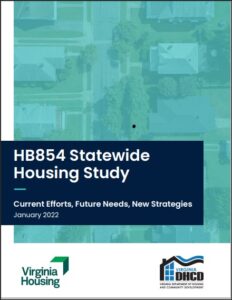A General Assembly-ordered study has published its findings for making housing more affordable and accessible for lower-income Virginians and minorities. One can only pray that the report is relegated to one of those proverbial shelves that collects dust, and is never to be seen again. Its recommendations, if followed, would steer resources into government programs while doing nothing to address the underlying cause of the ever-escalating cost of housing: the shortfall in new construction.
It’s not as if the authors of the Statewide Housing Study are ignorant of the laws of supply and demand. The research section of the study notes that roughly 30,000 new homes are built in Virginia each year, about half the annual production of the mid-2000’s. Virginia’s population has increased 10.2% since 2008, while housing supply has grown only 8.7%. Moreover, the housing type is out of whack. More than two-thirds of all new homes are detached, single-family dwellings, as opposed to less-expensive townhouses and apartments. By 2021, the imbalance of supply and demand pushed up the average cost of a single-family home by 30% over five years.
The report’s narrative also alludes briefly to the supply-demand equation. “The lack of inventory remains the biggest impediment to homeownership opportunities for Virginians,” it says in one place. And in another, it acknowledges, “Market conditions and local land use consistently put constraints on the availability and timing of new [rental] supply.”
While acknowledging that local zoning and land-use regulations are among the factors that impact housing affordability in Virginia, the authors state that this topic is deemed to be “beyond the scope of this study.”
Imagine that. This housing-affordability study ignores the primary economic forces affecting affordability. Instead, it focuses on tangential, second-tier factors. As an added bonus, it skews its analysis by viewing affordability through a racial lens rather than an income lens. “Stakeholders, along with both state housing agencies, unanimously agreed to add racial equity as a fifth focus area for significant recommendations.” [Bold face in the original quote.]
The results are predictable. The remedies call for greater government intervention in the housing marketplace rather than less. They emphasize transfer payments and subsidies. And they would steer resources and power to nonprofits and quasi-governmental organizations such as the two entities responsible for the study, Virginia Housing and the Virginia Department of Housing and Community Development (DHCD).
Such an outlook was probably baked into the process from the beginning. Of the 40 “stakeholders” consulted, only nine were representatives of private industry such as developers, home builders, Realtors, and financiers — the people who actually build, finance and sell the vast majority of housing. The other 31 were from governmental, quasi-governmental, nonprofit and academic entities. The process itself was steered by Virginia Housing and DHCD employees.
As part of their research, Virginia Housing and DHCD commissioned a survey of “a diverse and representative range of stakeholders” to address community housing needs, racial disparities, the efficacy of state housing policies, and the impact of COVID-19. The 400 respondents were heavily skewed to nonprofits (23%), local government (20%), homeless service providers (12%), public housing authorities (7%), housing counselors (7%). Only a third were in the for-profit sector.
Unsurprisingly, given this make-up, respondents perceived racial disparities in various categories of housing to be “significant” to “very significant,” and they were inclined to rate as “somewhat significant” to “significant” the efficacy of various governmental and nonprofit programs in addressing housing affordability. Market-based solutions were not provided as an option in the survey.
So, what did this process yield as far as recommendations?
- A statewide rental assistance program for lower-income Virginians;
- Utility rate reduction through a variety of taxpayer-funded initiatives;
- An amendment to the state constitution that would enable local governments to offer real estate tax relief for affordable housing and homeless purposes;
- Expanded and/or subsidized access to tax-free bonds for Virginia Housing and DHCD.
No list today would be complete without a racial-equity component. In this case, the study recommends expanding Black access to homeownership, mitigating the effects of gentrification, bolstering rental-assistance programs, and ensuring that “equity is considered at all levels of the housing industry.”
No one associated with the study appears to remember the last time social-justice activists lobbied — very successfully — to increase the rate of Black homeownership by reducing lending standards. It resulted in the sub-prime mortgage meltdown of 2008. The ensuing tsunami of foreclosures was the greatest setback to Black wealth accumulation since slaves were captured in Africa and transported to the New World.
The one thing we can all agree upon is that access and affordability to housing for lower-income Virginians is a major social problem. We can only hope that the Youngkin administration and General Assembly scrap this study and start over with an emphasis on the only viable long-term solution: building more housing and ensuring that housing type matches up with market demand.



